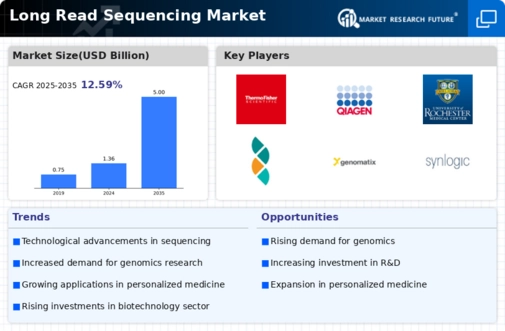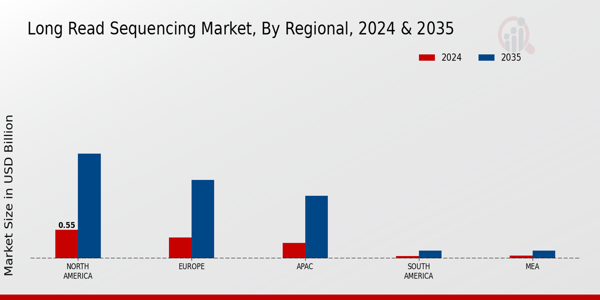Market Growth Projections
The Global Long Read Sequencing Market Industry is projected to experience substantial growth over the next decade. With a market value of 1.36 USD Billion in 2024, it is anticipated to reach 5 USD Billion by 2035. This growth trajectory indicates a compound annual growth rate of 12.56% from 2025 to 2035, reflecting the increasing adoption of long read sequencing technologies across various sectors. The expansion is driven by factors such as technological advancements, rising demand for genomic research, and increased funding for genomic initiatives. These projections highlight the industry's potential to transform genomic studies and clinical applications.
Rising Demand for Genomic Research
The Global Long Read Sequencing Market Industry is experiencing an upsurge in demand for genomic research across various applications, including personalized medicine and agricultural genomics. As healthcare systems increasingly adopt genomics to tailor treatments, the need for precise sequencing technologies becomes paramount. This trend is reflected in the projected market growth, with an anticipated value of 5 USD Billion by 2035. Furthermore, the integration of long read sequencing in clinical settings is likely to enhance diagnostic accuracy, thereby driving further investments in genomic research. This growing demand underscores the importance of long read sequencing in advancing scientific knowledge and improving patient outcomes.
Emerging Markets and Global Expansion
The Global Long Read Sequencing Market Industry is poised for growth in emerging markets, where increasing investments in healthcare infrastructure and research capabilities are evident. Countries in Asia and Latin America are beginning to adopt advanced sequencing technologies, driven by rising awareness of genomics' potential benefits. This expansion is likely to create new opportunities for market players, as local research institutions seek to implement long read sequencing in various applications. The global nature of this market suggests that as these regions develop their genomic capabilities, they will contribute significantly to the overall growth trajectory of the industry.
Technological Advancements in Sequencing
The Global Long Read Sequencing Market Industry is witnessing rapid technological advancements that enhance sequencing capabilities. Innovations such as improved polymerase enzymes and novel sequencing platforms are enabling longer reads with higher accuracy. For instance, the introduction of single-molecule real-time sequencing technology has revolutionized genomic studies, allowing researchers to sequence entire genomes more efficiently. These advancements are expected to drive the market's growth, with projections indicating a market value of 1.36 USD Billion in 2024. As technology continues to evolve, it is likely that the industry will see further enhancements, potentially leading to a more comprehensive understanding of complex genomes.
Increased Funding for Genomic Initiatives
The Global Long Read Sequencing Market Industry benefits from increased funding directed towards genomic initiatives by governments and private organizations. Various national health agencies are allocating substantial budgets to support genomic research, which in turn fuels the demand for advanced sequencing technologies. For example, initiatives aimed at mapping genetic variations in populations are gaining traction, leading to a surge in long read sequencing projects. This financial backing is expected to propel the market forward, with a compound annual growth rate of 12.56% projected from 2025 to 2035. Such investments not only enhance research capabilities but also foster collaborations between academia and industry.
Growing Applications in Clinical Diagnostics
The Global Long Read Sequencing Market Industry is increasingly recognized for its applications in clinical diagnostics, particularly in identifying genetic disorders and cancers. Long read sequencing provides comprehensive insights into complex genomic regions that traditional methods may overlook. As healthcare providers seek more accurate diagnostic tools, the adoption of long read sequencing is likely to rise. This trend is supported by the growing body of evidence demonstrating its efficacy in clinical settings. The market's expansion is anticipated to align with the broader shift towards precision medicine, further solidifying the role of long read sequencing in improving patient care and treatment strategies.









